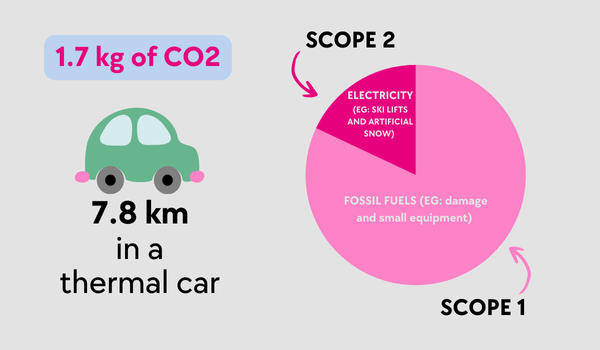CARBON FOOTPRINT OF A DAY'S SKIING AT LA ROSIÈRE
To fight climate change at corporate level, the imperative starting point is to measure greenhouse gas (GHG) emissions.
Carbon footprint of a day's skiing
The environmental impact of our practices and the carbon footprint generated by a day's skiing have been the subject of a study, which has resulted in the infographic on the side.
« The study highlights the dominance of transport in the carbon footprint of mountain holidays (52% of GHG emissions), followed by local facilities (17%) and ski-equipment (16%). »
The operation of a ski area accounts for 3% of the greenhouse gas emissions generated during a ski trip.
Infographic produced by Utopies/ADEME based on data from 3 tourist destinations: La Clusaz, Le Grand Bornand and Tignes for a day's skiing. Guide sectoriel filière sport, montagne et tourisme, February 2022
At La Rosière
SCOPES:
To measure the carbon footprint of a day's skiing at La Rosière, greenhouse gas emissions divided into 3 categories:
- SCOPE 1 = direct emissions
Here, this is fuel for snow groomers, heating of premises, etc. - SCOPE 2 = indirect energy-related emissions
Here, this is the electricity used to operate the ski lifts or produce the artificial snow. - SCOPE 3 = other indirect emissions
Here, these are the purchases of goods and services, and emissions linked to customers, such as transport to and from the ski resort, etc.
Analysis of CO2 emissions at La Rosière:
SCOPE 1 + SCOPE 2: direct and energy-related emissions
Including:
- Direct emissions related to Ski Area operations (SCOPE 1),
- The energy consumption required to run the ski area (SCOPE 2),
Each day's skiing at La Rosière generates an average of 1.7 kg of CO2 per skier(1), the same as driving about 8 km in an oil-powered car.
(1) Based on the Domaine Skiable de La Rosière's internal resources (e.g. meter readings) using the simplified method provided by Domaines Skiables de France (DSF) and covering the financial year from 01/10/2022 to 30/09/2023, assuming 575,043 skier days during the winter.

SCOPE 1 + SCOPE 2 + SCOPE 3 (EXCLUDING SKIER TRANSPORT)
- If all the GHG emissions of the three SCOPES are included, except for the transport of skiers to the resort, the result is the following:
Each day's skiing generates 4.03 kg of CO2 per skier(2), the same as driving about 18.5km in an oil-powered car.
(2) Data taken from the study carried out by Cabinet DAMOE at the request of the SOFIVAL group and the Domaine Skiable de La Rosière (April 2024). Calculation covering the financial year from 01/10/2022 to 30/09/2023, assuming 575,043 skier days during the winter.

SCOPE 1 + SCOPE 2 + SCOPE 3 (WITH SKIER TRANSPORT)
- When the emissions related to the transport of skiers to La Rosière are included, the result is significantly higher:
Each day's skiing generates 28.65 kg of CO2 per skier(3). This figure illustrates the major impact of travel on the total carbon footprint of skiing activities. Underlining the importance of more sustainable transport solutions to reduce these emissions.
(3) Estimation regarding the origin of the Domaine Skiable de La Rosière's clientele based on the results of an EFICEO satisfaction survey (3,599 respondents). Based on a calculation carried out by Cabinet DAMOE at the request of the SOFIVAL group and the Domaine Skiable de La Rosière (April 2024) and covering the financial year from 01/10/2022 to 30/09/2023, assuming 575,043 skier days during the winter.
Our initiative to reduce transport emissions :
Since winter 2020-2021, La Rosière Ski Area has been encouraging its visitors to prefer the train by offering them a 15% credit on their next purchase of ski pass(es). This measure aims to reduce GHG emissions and promote more sustainable and responsible tourism.

At present, it is impossible to calculate the overall carbon footprint of a day's skiing at La Rosière, as the data needed to assess GHG emissions linked to ski equipment, accommodation, food and infrastructure are not yet available.
The key points:
The notion of SCOPE is essential for understanding and comparing the carbon footprint of a day's skiing. It is easy to underestimate GHG emissions if all the SCOPEs are not taken into account in their entirety. But it is also essential for realising that, on its own, the La Rosière Ski Area cannot make a drastic contribution to reducing the GHG emissions recorded above.
In addition to the direct emissions linked to its activity, the La Rosière Ski Area must take action throughout its value chain, both upstream and downstream, with its suppliers and visitors.
This implies the implementation of an appropriate internal policy, with the involvement of its suppliers. In addition, as visitor transport is the main source of greenhouse gas emissions, this also means implementing a policy to decarbonize visitor transport.
In the light of data and conclusions of these studies, the La Rosière Ski Area is actively committed to reducing its greenhouse gas emissions:
- Through a charter of commitment to energy efficiency, specific to its structure:
- By implementing a number of concrete eco-responsible actions:



















